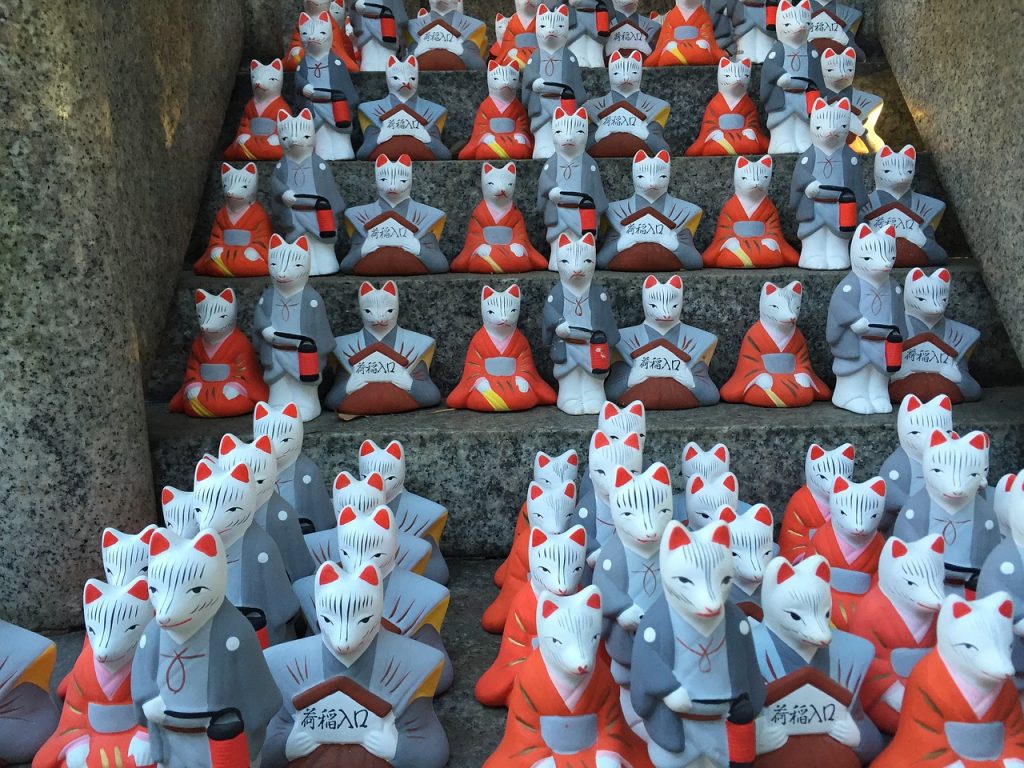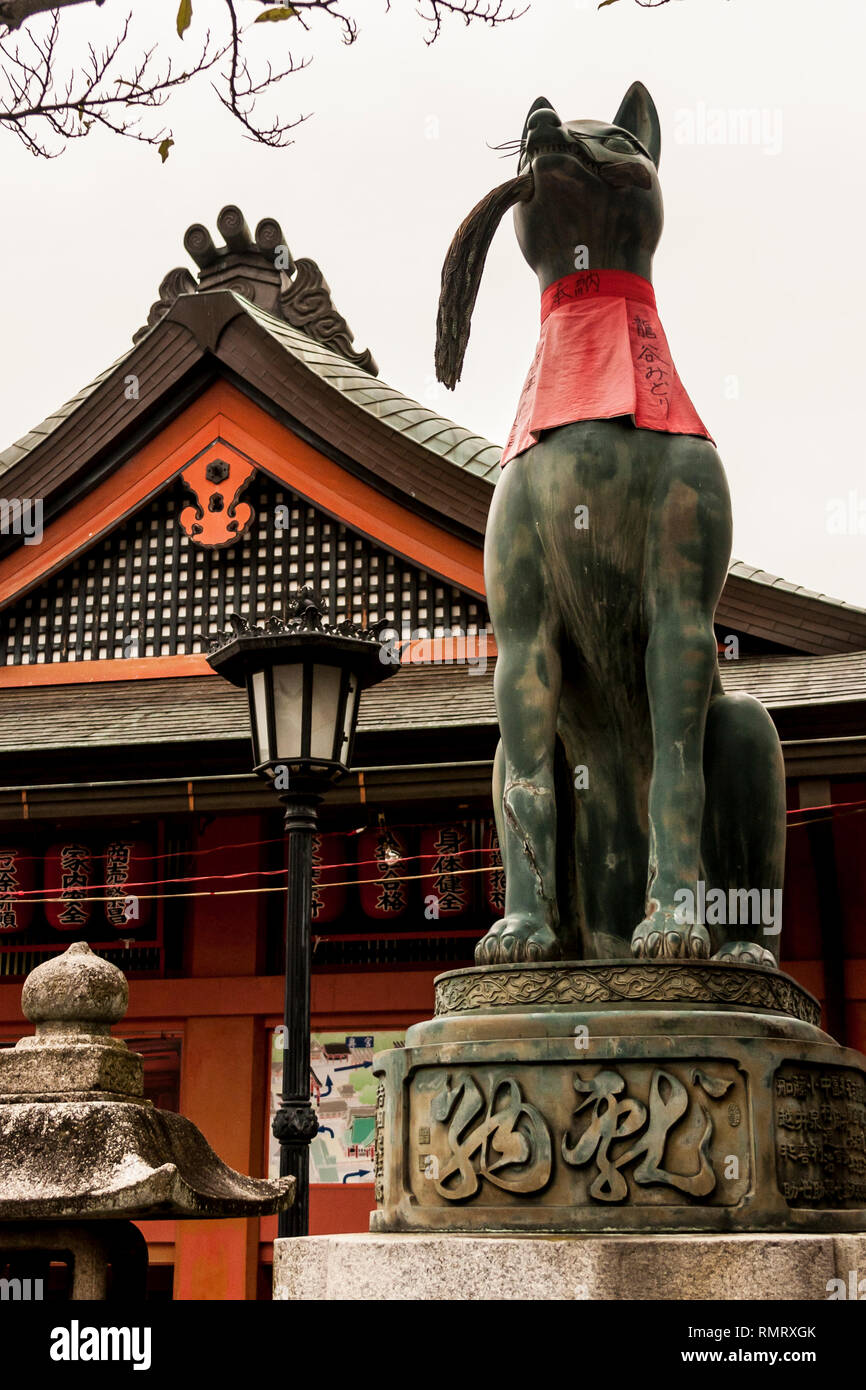
Fox Statue in Fushimi Inaritaisha Shrine Editorial Image Image of japanese, fushimi 148062855
The Fox Messenger. While exploring Fushimi Inari, you will notice many fox (kitsune) statues along the path and near the shrines. The reason for this is that foxes are often considered to be the messengers of the god Inari. Foxes are found at all shrines that are dedicated to Inari throughout Japan. Some foxes in the temple have more than one tail.

Japan Kyoto, Fushimi Inari cemetery fox Fox statue on a S… Flickr
Fushimi Inari Taisha is a shrine known for its strong worship of "Inari", a deity represented by foxes in Japanese folklore. The shrine grounds are filled with numerous stone statues of foxes of various sizes, and the large fox statues around the main hall are particularly famous.

Fox Statue at Fushimi Inari Shrine (Illustration) World History Encyclopedia
In the photo above you see one of the many "kitsune" (fox) statues at Fushimi Inari Shrine. The foxes are said to be messengers of the god "Inari". By the end of this blog entry you'll hopefully understand how big the biggest Inari Shrine actually is. The main symbol of Fushimi Inari Shrine: the red gates - here the mini version of.

File20100714 Fox statues in Fushimi Inari Shrine Kyoto Imgp1627.jpg
The following 130 files are in this category, out of 130 total. 20100714 Fox statue in Fushimi Inari Shrine 1546.jpg 2,300 × 3,377; 3.27 MB 20100714 Fox statue in Fushimi Inari Shrine 1583.jpg 1,954 × 2,563; 2.3 MB 20100714 Fox statue in Fushimi Inari Shrine 1633.jpg 2,680 × 4,035; 4.45 MB

Fox Statue in Fushimi Inaritaisha Shrine Stock Photo Image of oriental, asia 148063666
Inari is the Shinto god of rice, the protector of food, and bringer of prosperity. He has over 40,000 shrines dedicated to him large and small across Japan, the oldest and most important of which is the Fushimi Inari Shrine near Kyoto with its famous red torii gates and fox statues in honour of the animal which is considered the god's messenger and guardian.

A Travellers Guide To The Kyoto Fox Shrine Home Of The Mythical Ianri Foxes 力
Fushimi Inari Shrine is located in the Fushimi Ward of Kyoto City. One of the most popular sightseeing spots in Kyoto, Fushimi Inari Shrine is the head shrine of the Inari shrines, and there are said to be around 30,000 sub-shrines dedicated to the god of rice, Inari, in Japan. Many people may think of the imposing romon two-storied gate of the.

Fox statue in Fushimi Inari Taisha Shrine in Kyoto Japan Japanese statue, Inari, Statue
Fushimi Inari-Taisha is by far Japan's most popular shrine, known for its thousands of orange gates and fox statues. The Fushimi Inari-Taisha shrine was built in 711 to honour Inari, the Shinto god of rice.

The Fox Statues in Fushimi Inaritaisha, Achitecture, Kyoto, Japan Editorial Photo Image of
Features Fox Statues As you walk through Fushimi Inari Shrine you will notice that you are surrounded by fox statues, foxes being considered messengers of the god Inari.

Kyoto,Japan December 27, 2009 Fox statue at the Fushimi Inari Shrine in Kyoto,Japan. Almost
The light-hearted series takes place in Kyoto and features real-life locations like the famous Fushimi Inari Taisha (mentioned below) making it a fun read or watch for fans of the city. 6 Must-Visit Inari Shrines in Japan. Interested in checking out some Inari fox statues in person? There is no better place to do so than at a shrine dedicated.

Fox statue holding a key in its mouth at the entrance of Fushimi Inari Shrine in Kyoto Stock
Fushimi Inari Taisha Shrine is one of the most notable Shinto shrines located at the foot of Mount Inari, which is considered sacred as a whole, in southern Kyoto. It is the head of over 30,000 Inari shrines across the nation that are prayed to for a good harvest. A grain deity named Ukano-mitama, also known as Oinari-san, is enshrined there.

Fushimi Inari Shrine GaijinPot Travel
The Fushimi Inari Shrine near Kyoto ( Heiankyo ), Japan is the largest and most important shrine dedicated to Inari, the Shinto god of rice and prosperity. It is famous for the large number of red gates (torii) at the site. The shrine was founded in 711 CE. In Shinto mythology the fox is Inari's vehicle and guardian.

File20100714 Fox statue in Fushimi Inari Shrine 1633.jpg Wikipedia
Fushimi Inari is a free shrine in Kyoto, Japan with vermilion torii gates stretching endlessly. This post details our experience hiking through over 10,000 torii gates, shares photos of the experience, and offers tips for visiting Fushimi Inari, sometimes known as the "Fox Shrine."

FushimiInari Taisha Shrine I Love Kyoto
A pair of Fox statues are the symbol of Inari Shrines. Main Shrine. There are as many as 30,000 Inari shrines throughout Japan, and Fushimi-Inari is the grand head shrine of all of them.. Deep-fried Tofu is Fox's favorite food. At Fushimi-Inari, you can also see BBQed Sparrow skewers sold at the street stalls near the main shrine. Again.

Kitsune or fox statue at a shrine in Fushimi Inari Taisha Kyoto Inari, Fushimi inari taisha, Japan
The Fushimi Inari Shrine or the Kyoto Fox Shrine (伏見稲荷大社, pronounced Fushimi Inari Taisha in Japanese) is an important Shinto shrine in southern Kyoto and one of the most popular tourist sites in the whole of Japan.

Fox guardian statue at Fushimi Inari shrine, Japan Japanese shrine, Japan culture, Inari
Fushimi Inari Shrine (伏見稲荷大社, Fushimi Inari Taisha) is an important Shinto shrine in southern Kyoto. It is famous for its thousands of vermilion torii gates, which straddle a network of trails behind its main buildings. The trails lead into the wooded forest of the sacred Mount Inari, which stands at 233 meters and belongs to the shrine grounds.

There are many fox statues across the Fushimi Inari Shrine. Foxes are... News Photo Getty Images
Originally established in 711 CE by Korean lords of the area, Fushimi Inari Shrine is the most famous of several thousand shrines dedicated to Inari, the Shinto god of rice. Foxes are.